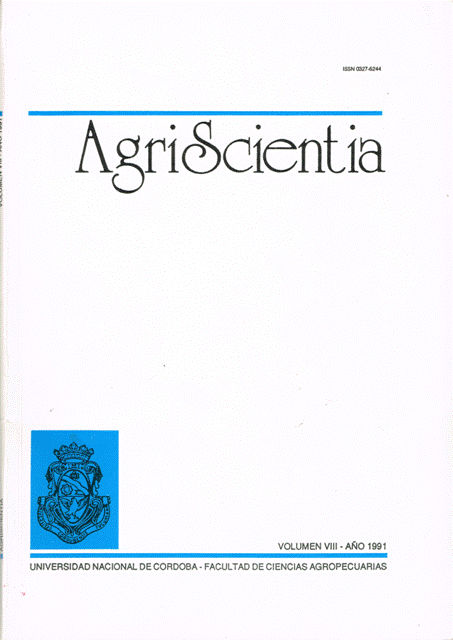Regulación hormonal de la dormancia en ajo (Allium sativum L.) cv Rosado Paraguayo
Contenido principal del artículo
Resumen
Para establecer la localización del mecanismo de control de dormición y el papel de diferentes reguladores del crecimiento sobre el mismo, dientes de semilla de ajo (dormidos, en salida de dormición y en brotación) se cultivaron in vitro con medio nutritivo y diversas fitohormonas. También se evaluó la presencia de sustancias tipo GAs (fracciones libres ácidas y conjugados glucosídicos), tipo auxinas y tipo inhibidores del crecimiento. Los resultados mostraron que las citocininas fueron efectivas durante la dormición en los procesos de diferenciación (aunque no se puede descartar el papel de las auxinas); las GAs fueron importantes hacia la salida de dormición, quizás movilizando carbohidratos. La actividad tipo auxinas fue altamente significativa cuando comenzaba la expansión de tejidos (una vez que la condición durmiente había desaparecido). El conjunto de fitohormonas (ABA incluido) parecería ser importante en los procesos de crecimiento/diferenciación, debido al efecto notable de su aplicación en forma de mezcla sobre los explantos cultivados in vitro. Así, las hojas embrionarias deben superar diversos pasos de diferenciación (que dependen de influencias de naturaleza hormonal, nutricional y físico-química por parte de la hoja de reserva) antes de brotar.
Detalles del artículo

Esta obra está bajo una licencia internacional Creative Commons Atribución-CompartirIgual 4.0.
Cómo citar
Referencias
Abo-El Nil, M.M. and F.W. Zettler, 1976. Callus initiation and organ differentiation from shoot tip cultures of Calocasia esculenta. Plant Sci Letters 6. 401.
A de Bottini. G., R. Bottini and R. Tizio, 1982. Physiology of dormancy in potato tubers as related to levels of endogenous regulators. Phyton 42, 115.
Altman, A. and R. Goren, 1974. Growth and dormancy cycles in citrus bud cultures and their hormonal control. Physiol Plant 30, 240.
Arguello, J. A., R. Bottini, R. Luna, G. A de Bottini and R.W. Racca, 1983. Dormancy in garlic (Allium sativum L.) cv Rosado Paraguayo. Levels of growth substances in "seed cloves" under storage. Plant Cell Physiol 24 1559.
Arguello, J. A., 1987. Fisiología de Post-Cosecha en ajo (Allium sativum L.) Contribución al estudio del mecanismo de la dormición y la brotación. Tesis doctoral. Universidad Nacional del Sur (Argentina).
Borkawska, B. and L.E. Powel, 1979. The dormancy status of apple buds as determined by in vitro culture systems. J Amer Soc. Hort Sci 104, 708.
Correa, N. S., R. Bottini, G. A. de Bottini, L. Goleniwski and L. Gordon, 1975. Cambios en los niveles de inhibidores del crecimiento y de giberelinas endógenas durante el reposo vegetativo de yemas de duraznero. Phyton 33. 193.
Goodwing, P.B., 1983. In: The growth of the potato. Ivins, J.D., Milthorpe, F.L. eds, pp 63. Butterworths, London.
Kothari, I.L., 1979. Morphohystogenic and anatomical studies in garlic: Phloem. Proc Indian Acad Sci 88.219.
Lewak, S., 1979. Hormonal Regulation of dormancy in plants. Acta Horticultural 91. 41.
Luna, V., E. Lorenzo, H. Reinoso, M.Tordable, G. Abdala, R.P. Pharis and R. Bottini, 1990. Dormancy in peach (Prunus Persica L.) flower buds. I. Floral morphogenesis and endogenous gibberellins at the end of the dormancy period. Plant Physiol 93, 20.
Mahotiere, S. R.C. Heiner, F G. Dennis, 1976. Effects of applied growth substances on growth of shoots apices excised from onions in rest. Physiol Plant 110, 211.
Murakami, Y., 1968. New rice seedling bioassay for gibberellins "Microdrop Method" and its use for testing extracts of rice and morning glory. Not Mag 81, 33.
Murakami, Y., 1973. A method for detecting bound gibberellins by rice seedling test. Chem Reg Plants G. 40.
Naver, E.M. and S.B. Boswell, 1981. Stimulating growth of quiescent citrus buds with 6-benzylaminopurine. Hort Sci 16 162.
Phillips, I.D.J., 1962. Some interactions of gibberellic acid with naringenin (5, 7, 4 tri-hidroxi f lavonone) in the control of dormancy and growth in plants, J Exptl Bot 13, 213.
Rakhimbaev, I.R.; OI'Shamskaya., 1976. Dinamics of endrogenous gibberellins during the process of transition of garlic from the state of dormancy to active growth. Soviet Plant Physiot 23, 76.
Rakhimbaev, I.R. and V.F. Solomina, 1980. The activity of endogenous cytokinins during garlic storage at low temperature. Vestnik Set Khoz Nauki Kazakhstana 2, 46.
Rappaport, L., M.D. Blumenthal-Goldschmith and O.E. Smith, 1965. Regulation of bud rest in tubers of Solanum tuberosum L. I. Effect of growth substances on excised potato buds. Plant Cell Physiol 6, 587.
Sanchez, R.A. and L. De Miguel, 1983. Aging of Datura lerox seed embryos under dry storage and its reversal during inhibition. Z. Pflanzephysiol 110. 319.
Shibakusa, R., 1979. Studies on the dormancy of Abbiessanchalimensis Masters. (IV). Effects of growth substances on the growth of cultures embryonic shoots in the dormant period. Jap Forestry Soc. 61, 47.
Stow, J.R., 1976. The effects of defoliation on storage potential of bulbs of the onion (Album cepa). Ann Appl Biol 84, 71.
Stritzke, J.E and E.J. Peters, 1970. Dormancy and sprouting cycles of wild garlic. Weed Sci 18, 122.
Thomas, T H , 1969. The role of growth substances in the regulation of onion bulb dormancy. J. Exptl Bot 20, 124.
Thomas, T.H., 1981. Hormonal control of dormancy in relation to post-harvest horticulture. Ann Appl Biol 98, 525.
Tizio, R., 1982. Fisiología de la dormición en tubérculos de papa y sus relaciones con el mecanismo hormonal de la tubenzación. Rev Cs Agropecuarias, 111.91.
Weinberger, J H., 1969. The simulation of dormant peach buds by a cylokinin. Hon Sci 4, 125.





